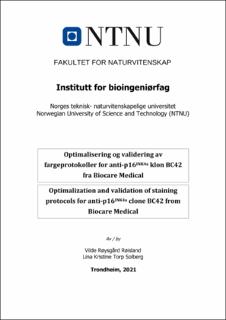| dc.contributor.advisor | Wålberg, Lise Eid | |
| dc.contributor.advisor | Grilingås, Asle | |
| dc.contributor.author | Røisland, Vilde Røysgård | |
| dc.contributor.author | Solberg, Lina Kristine Torp | |
| dc.date.accessioned | 2021-09-25T16:59:44Z | |
| dc.date.available | 2021-09-25T16:59:44Z | |
| dc.date.issued | 2021 | |
| dc.identifier | no.ntnu:inspera:82853603:36899329 | |
| dc.identifier.uri | https://hdl.handle.net/11250/2783552 | |
| dc.description.abstract | Dette prosjektet ble gjennomført som den avsluttende bacheloroppgaven for bioingeniørutdanningen tilhørende Institutt for bioingeniørfag ved det Naturvitenskapelige Fakultet på Norges teknisk- naturvitenskapelige universitet (NTNU). Oppgaven ble gitt av Enhet for immunhistokjemi ved Avdeling for patologi, St. Olavs hospital. Hensikten med prosjektet var å undersøke mulighetene for bytte av primærantistoff i immunhistokjemisk farging for proteinet p16INK4a. Det aktuelle nye antistoffet er anti-p16 INK4a klon BC42 fra Biocare Medical. Bakgrunnen for dette er et ønske om kostnadsbesparelse. Det aktuelle anti-p16INK4a inngår også i en dobbeltfargeprotokoll sammen med anti-Ki67. Dobbeltfargeprotokollen er derfor også vurdert i denne oppgaven. Bruksområdet til disse fargeprotokollene er hovedsakelig i diagnostikk og utredning av kreft oppstått som følge av infeksjon med Humant papillomavirus (HPV). I tillegg benyttes de i utredning av maligne melanomer. I mai 2022 vil EUs nye IVD-regulativ tre i kraft. Alle fargeprotokoller som benyttes, eller skal innføres i diagnostikken ved medisinske laboratorier, må derfor vurderes og godkjennes i henhold til dette regulativet.
For å undersøke problemstillingen ble det utført en optimalisering og verifisering av anti-p16INK4a klon BC42 i enkeltfargeprotokoll for p16 samt dobbeltfargeprotokollen for Ki67/p16 i henhold til laboratoriets prosedyrer. Det ble testet ut ulike forbehandlingsmetoder. Til deteksjon av primærantistoffet ble deteksjonskit OptiView DAB og UltraView AP Red fra Ventana/Roche benyttet. Det ble benyttet litteratursøk for å undersøke forholdene knyttet til IVDR.
Den best egnede protokollen for p16-enkeltfargen ble 48 min HIER forbehandling med CC1 buffer fra Ventana, 12 min inkubering med primærantistoffet og bruk av pre-peroxidase inhibitor. Denne protokollen gav like god, tidvis bedre, fargekvalitet enn den nåværende p16-enkeltfargeprotokollen. Protokollen er utformet i henhold til kravene satt i IVDR. For Ki67/p16-dobbeltfargeprotokollen ble protokollen med 48 min HIER forbehandling med CC1 buffer, 32 min og 12 min inkubering med henholdsvis anti-Ki67 og anti-p16INK4a, samt amplifisering, den best egnede protokollen. Dobbeltfargeprotokollen gav også minst like god fargekvalitet som den nåværende Ki67/p16-dobbeltfargeprotokollen. Denne protokollen kan ikke umiddelbart godkjennes i henhold til IVDR og vil trolig måtte gå under «in house»-unntaket. Videre ble det funnet at bytte av primærantistoff vil medføre en betydelig kostnadsbesparelse for de to fargeprotokollene. | |
| dc.description.abstract | This project was conducted as the final bachelor’s thesis for the biomedical laboratory engineering program at the Department of Biomedical Laboratory Science by the Faculty of Natural Science, at the Norwegian University of Science and Technology (NTNU). The project was initiated by the Unit of immunohistochemistry at the Department of Pathology at St. Olavs hospital. The purpose of this project was to investigate the possibilities of replacing the primary antibody used in staining of the protein p16INK4a. The new antibody tested is anti-p16INK4a clone BC42 from Biocare Medical. The reason for this is savings in cost for the staining method. The p16INK4a-antibody will also be used in a double staining method together with anti-Ki67. This protocol is also evaluated in this project. These staining methods are used in diagnosis of cancers formed as a result of human papilloma virus (HPV) infection. In addition, they are used in evaluation malignant melanomas. In May of 2022 the new EU regulative regarding IVD-equipment will come into effect. All staining methods in diagnostic use at the laboratories will have to be evaluated and approved according to these regulations. The staining methods in this project were therefore evaluated to provide the laboratory with information on which demands are placed upon them regarding documentation in the introduction of these methods.
To investigate the issue an optimalization and verification of the p16 INK4a clone BC42 antibody in a single and a double staining method was conducted. The optimalization tested different pre-treatment options. For the detection of the primary antibodies OptiView DAB and UltraView AP Red detection kits from Ventana/Roche were used. A study of literature was conducted to find information regarding the IVDR.
The results of the p16 INK4a single staining method using 48 minutes of HIER with Ventana’s CC1 buffer solution, 12 minutes incubation time with the primary antibody and use of peroxidase inhibitor were equivalent, and in some cases better than, the existing staining method for p16INK4a. The staining method was found to be in accordance with the IVDR. The method for double staining Ki67/p16 used 48 minutes of HIER with CC1 buffer, 32 minutes and 12 minutes incubation time with Ki67- and p16-antibody respectively, as well as an amplification step. This method also resulted in a high-quality staining comparable to the existing method. This staining method was not found to be in accordance with the IVDR, and will have to be evaluated in regards to the “in house”-exception. It was concluded that the change in primary antibody for these staining methods was favourable in regards to cost. | |
| dc.language | nob | |
| dc.publisher | NTNU | |
| dc.title | Optimalisering og validering av fargeprotokoller for anti-p16INK4a klon BC42 fra Biocare Medical | |
| dc.type | Bachelor thesis | |
